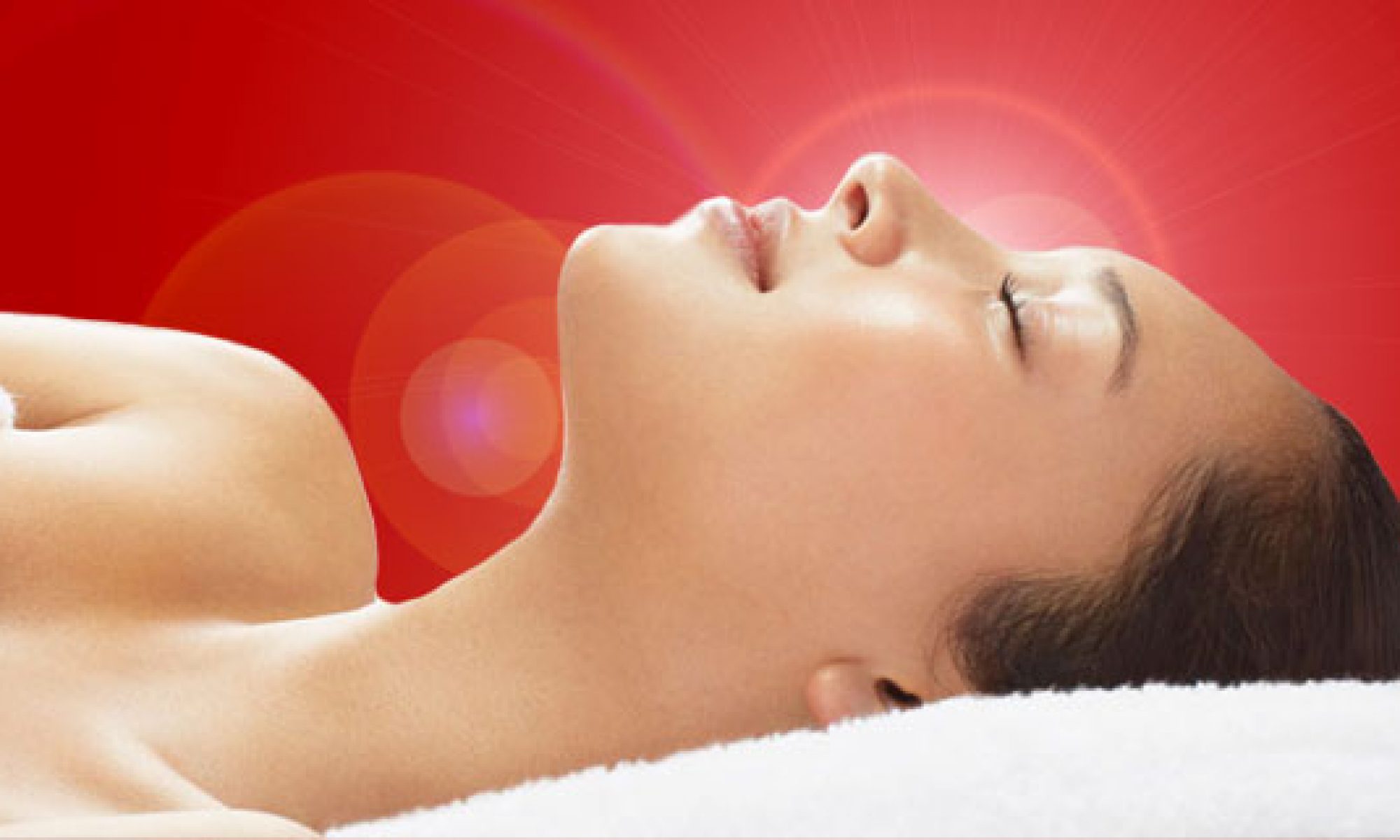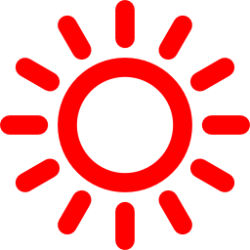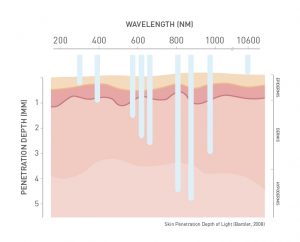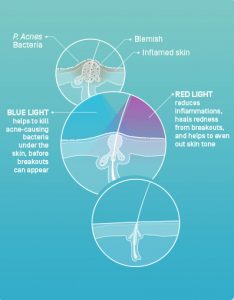What is Red Light Therapy?
Red Light Therapy uses wavelengths of visible red light from the 630 — 660 nanometers, and the invisible infrared light at 880 nm. Because these wavelengths are longer than other types of light, they penetrate deep into the skin. The National Aeronautics and Space Administration (NASA) has found that red light therapy treatments can increase cellular growth by up to 200%. While Light Therapy has been used for many years for many different types of treatments, the narrower red light band is only now starting to be adopted for medical and cosmetic uses.
What is Red Light Therapy Used For?
Certain kinds of light are good for us. Just as plants convert light into energy, human skin cells are stimulated by light to heal and improve their performance. As we age, our cells begin to perform poorly and our skin loses its youthful appearance. This means we take longer to heal, our skin sags, and our body begins to ache. Red light therapy helps with these processes.
Red Light Therapy for…Wrinkle Reduction
Once the infrared light reaches the dermal layers, it stimulates the activity of fibroblasts, which are responsible for making the proteins collagen and elastin. Collagen and elastin are responsible for supporting the skin and giving it its elasticity. Replenishing the collagen and elastin helps smooth fine lines. Treatments using red light will improve skin tone and texture, control pigmentation spots, help reduce pore size, encourage vibrant, healthier-looking skin, and reduce fine lines. Anti-aging red light therapy stimulates circulation and repairs the elastin fibers within tissue to help keep skin firm.
Pain Reduction
Infrared light uses a relatively longer wavelength, penetrating to a depth of 30-40 mm, which makes it effective for problems with bones, joints, and deep muscles. The dermal layers, with high water and blood content, absorb red light very readily. This makes read light therapy beneficial in treating problems close to the skin surface, such as fine lines, and in promoting the healing of inflamed acne, wounds, cuts, scars, and infections. It has also been recommended as a post-care treatment for fractional laser, dermal roller, chemical peel, and dermabrasion.
Acne Treatment
The right kind of light can do wonders for our skin, which is why leading dermatologists use light therapy to treat acne. Acne starts when a build-up of oil (sebum) causes Propionibacterium acnes (P. acnes), the bacteria that cause acne, to multiply. These bacteria then clog the pores of your skin, along with excess oil and dead skin cells, causing inflammation resulting in acne breakouts. Red light therapy lets you treat acne in just minutes a day by eliminating acne-causing bacteria and healing inflammation from existing breakouts.
Red light therapy is a safe, affordable, and effective treatment for mild to moderate acne, with no UV rays. Getting treated at a full-body machine means your entire face (and body) is exposed all at once. The red light works to kill P. acnes bacteria and to heal inflammation from existing breakouts. When the light hits your skin, the light-sensitive compounds contained in the P. acnes bacteria absorb the light and generate a photochemical reaction, killing the bacteria.
Red light helps rid the skin of acne by helping it heal and rejuvenate itself. Red light energy penetrates more deeply into the skin to decrease inflammation, increase blood circulation, and stimulate the healing of skin tissues. Red light therapy has been clinically proven to be effective at reducing acne lesions.
Other Uses
Red light therapy is also often used to reduce the appearance of scars, stretch marks, and to help with the healing of lesions. There are other uses as well. You are encouraged to seek the advice of your doctor to see if red light therapy is appropriate for your condition.
How Many Treatments Does It Take?
The number of red light treatments it takes is going to vary considerably depending on your condition, its severity, and the equipment used. Some equipment, like the one shown in the video above, is only meant for spot treatments. Other equipment, such as the Beauty Angel booth, will expose your whole body at once and may offer other benefits as well and therefore may be faster. In general, though, you will find noticeable cellular improvements after seven to ten treatments. Most people find it optimal to use red light therapy about once every 3 days and to continue on that schedule for as long as you want the benefits to last. While typically not harmful, doing more than 3 sessions per week will likely not produce any additional benefit.
Types of Red Light
There are different types of red light machines on the market, though as a whole the FDA (Food and Drug Administration) has been very strict about what is permitted. For example, it is not uncommon for a salon to take a tanning bed and put red-light lamps in it. However, according to the FDA, this is illegal and strictly not permitted. In the eyes of the FDA, tanning lamps and red light lamps are completely different “medical” devices and you may not change the function of the machine by putting in red light lamps. Aside from the Ergoline Beauty Angel, there are almost no machines on the market today that have been authorized by the FDA for red light. From a practical point, this may not matter given that a tanning bed that’s been refitted with red light lamps would do the task. However, from a legal perspective, it does matter and there are other considerations that benefit from FDA monitoring, such as exposure times (how long each session is) and safety as a whole.
Concerns and Limitations
While there are no major negative side effects of red light therapy and it appears to have no effect on healthy cells, it is not a magic solution to all of your skin imperfections and aches. There are limitations. For example, while it is highly effective in reducing fine lines, you are unlikely to eliminate moderate to deep wrinkles. If you have sensitivity to light, you should avoid any type of light-treatment including red light therapy without first consulting your doctor. When used for collagen and elastin production, the effects of red light therapy are not permanent. While some report improvements lasting many months after treatment is discontinued, eventually the skin will return to its pretreatment condition. That means wrinkles will return. However, when used as a treatment for temporary conditions, such as acne or lesions, the effects may be long-lasting or even permanent. Results will vary for each individual.
Cost
Your cost is going to vary considerably from location to location and device to device. Also, not all equipment is the same. In Hawaii, red light therapy is rare to find and if you want something more comprehensive, such as a total body enhancement, visit Sun Splash Tans on Kapahulu Avenue in Honolulu. If you want something very basic for very small spot treatments to use at home, a search on Amazon.com or Google for “red light therapy devices” will give you a good starting point. You should not expect the same results from small, inexpensive home devices compared to professional grade whole body equipment, but if your needs are very basic and localized, they may be worth researching. It’s also worth noting that LED red light is somewhat different than other forms.
Best Place to get Red Light Therapy
As we mentioned before, if you want red light therapy equipment that’s been reviewed by the FDA, stick with the Beauty Angel, which is available at Sun Splash Tans in Honolulu. If it doesn’t matter to you, a quick Google search will turn up other options near you.
Sun Splash Tans
625 Kapahulu Ave
Honolulu, HI 96815
DISCLAIMER: The information provided on this website is not medical advice. You should seek the advice of your doctor before beginning any light therapy for any condition. Nothing in the information provided is intended to be legally binding and has not been reviewed by the FDA or any other governing body.



